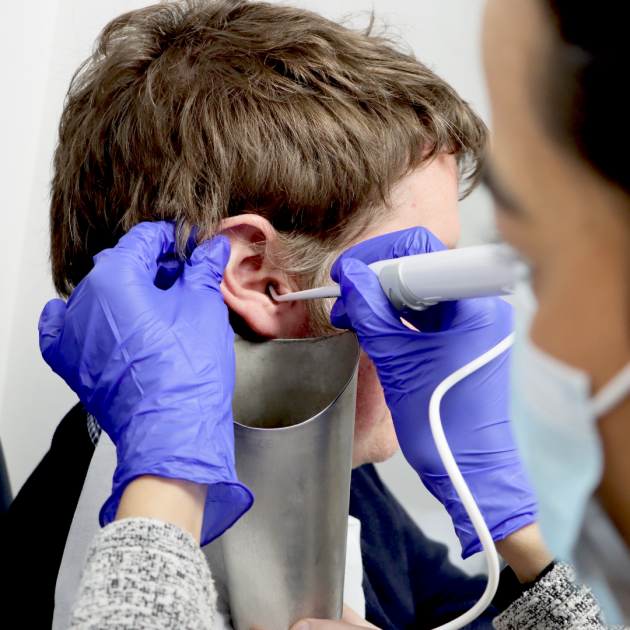
Ear wax, or cerumen, is a secretion that your ear naturally produces. In fact, it’s a perfectly healthy substance that helps protect your ear canal from bacteria, water, and other external irritants.
But sometimes ear wax build up can become uncomfortable and even affect your hearing. That’s when specialist ear wax removal is necessary.
Ear Wax and its Functions
What is ear wax?
More scientifically known as cerumen, ear wax is made up of dead skin and secretions from glands in your ear. The oily, sticky substance is antibacterial, antifungal and water repellent – protecting your delicate ear canal from outside harm and infection.

Normal ear wax production
As mentioned above, ear wax production is completely healthy and normal for your ears. In fact, it helps the ears to be ‘self-cleaning’, naturally pushing out dead skin and debris from within your ear canal.
Signs and Symptoms of Excessive Ear Wax Build-up
Earache or pain
If you are experiencing discomfort, sharp pains or earache in your ears, you may be suffering from symptoms of ear wax build-up. This is because ear wax build-up causes pressure within the ear canal on ear drum.
Reduced hearing or feeling of fullness
Have you noticed that your hearing is worse than usual? Or perhaps your ears feel full, like you’re wearing ear plugs, even though you’re not. This could be because a blockage of ear wax is preventing your perception and conduction of external sounds – much like a pair of ear plugs would.
Itching or discomfort
One of the most common ear wax build-up symptoms is a feeling of itchiness within your ears. And it can be tempting to stick something in there to have a good scratch. But you should never stick anything into your ear – whether that’s a cotton bud, hair pin, or fingernail – as you could risk further blockage and damage to your ear canal.
Tinnitus
Noticed an unusual ringing, buzzing, whooshing or humming noise in your ears? According to Tinnitus UK, this could be because ear wax build-up is blocking out external sounds, and making internal tinnitus noises more noticeable. Thankfully, with ear wax build-up treatment, your perception of these tinnitus sounds should decrease.
Vertigo
The NHS also lists vertigo – where you feel sick and dizzy – among its signs of ear wax build-up. That’s because the ears are crucial for balance, and so if something is affecting our ears, it can throw our balance off and make us feel dizzy or wobbly.

Seeking Professional Help and Safe Ear Wax Removal
Safe methods for ear wax removal
If you have wax build-up in your ears, there are various safe methods for ear wax cleaning you can try.
Prevention – because prevention is always better than a cure! You can prevent ear wax build-up by avoiding wearing earphones and earplugs for prolonged periods, as well as not ‘over-cleaning’ your own ears and never sticking cotton buds or other implements in your ears – as this could actually push ear wax further into your ear canal.
At home remedies – a pharmacist, GP or audiologist may prescribe you medical-grade olive oil ear drops, which can soften the wax and encourage small blockages to come our naturally. With three to four applications per day, excess ear wax should fall out over a period of about 2 weeks.
Professional ear wax removal – unfortunately, most GP practices no longer provide ear wax removal, because it’s been deemed a non-essential service. But at Leightons, a full consultation and removal carries an affordable, flat fee, so you don’t need to worry about costs.
When you book an appointment for ear wax removal with us, your expert audiologist will examine your ears and determine the best method for cleaning. There are three main treatments, used for different levels of wax build-up, including irrigation, microsuction and manual cleaning methods.
Signs of infection or injury: Immediate Medical Attention
If you have any of the above symptoms of ear wax build-up, but are also experiencing:
- Severe pain
- Fever
- Discharge or bleeding from the ear
then you ought to seek medical attention from your GP or audiologist immediately. Especially if these symptoms persist or worsen over time.
Ear wax removal near me: Book an appointment at your local branch
Ears feeling itchy, achy, or blocked? Noticed an unusual ringing in your ears or symptoms of vertigo? Struggling to hear properly? Then it’s a good time to book in an appointment for ear wax removal.
Getting seen quickly will help you stay comfortable, prevent any further damage to your ears and avoid long-term hearing damage.
You can book an appointment at your local branch online, or over the phone on 0800 40 20 20 today, for a time that suits you.








